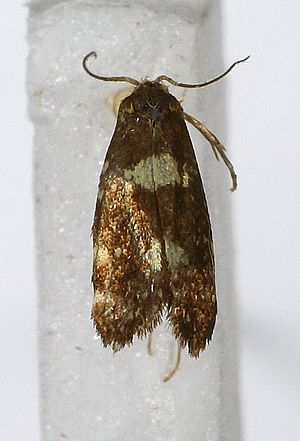Prodoxidae facts for kids
Quick facts for kids Prodoxidae |
|
|---|---|
| Scientific classification |
|
| Kingdom: | Animalia |
| Phylum: | Arthropoda |
| Class: | Insecta |
| Order: | Lepidoptera |
| Superfamily: | Adeloidea |
| Family: | Prodoxidae Riley, 1881 |
| Genera | |
|
Greya |
|
| Diversity | |
| About 9 genera and 98 species | |
The Prodoxidae are a family of moths. These moths are usually small and don't look very fancy. Some of them can be a bit of a problem for plants, like the currant shoot borer. But others, like the famous "yucca moths," have amazing and unique lives!
Contents
Meet the Prodoxidae Moths
Prodoxidae moths are an old group of moths. They are small to medium in size. Some of these moths fly during the day. For example, Lampronia capitella is known as the currant shoot borer. Gardeners in Europe know this moth well.
Other types of Prodoxidae moths live in different parts of the world. Some are found in Africa and Asia. Many common kinds live in dry areas of the United States. For instance, Tetragma gei eats mountain avens plants. Greya politella lays its eggs in the flowers of Saxifragaceae plants. Most Prodoxidae moths live in northern areas. However, Prodoxoides asymmetra lives in Chile and Argentina.
The Amazing Partnership of Yucca Moths and Plants
"Yucca moths" are very special. They have a close and long-standing relationship with Yucca plants. These moths are the only ones that can pollinate yucca plants. This means they help the plants make seeds. The moths also eat parts of the plants.
This relationship can be different for various moths and plants. It can be a helpful partnership (called mutualism). Sometimes, one benefits without harming the other (called commensalism). Other times, one might harm the other (called antagonism). You might see holes in yucca plant trunks where these moths have been.
How Yucca Moths Help Yucca Plants Reproduce
Two types of yucca moths, Tegeticula and Parategeticula, have a special partnership with yucca plants. Yucca plants can only be pollinated by these moths. In return, the moth larvae (baby moths) eat only yucca seeds.
Here's how it works:
- Female moths use their special mouthparts to put pollen into the yucca flower.
- They lay their eggs inside the flower's ovary.
- The moth larvae then eat some of the developing seeds. They don't eat all of them, so the plant can still make new plants.
This helpful partnership is like the one between the senita cactus and the senita moth.
Other Yucca Moths
Not all yucca moths are part of this pollination partnership. Moths from the genus Prodoxus do not pollinate yucca plants. Their larvae also do not eat developing seeds. Instead, their eggs are laid in the plant's fruits and leaves. The larvae eat and grow there until they are ready to emerge.
Sometimes, a yucca moth might "cheat." For example, Tegeticula intermedia lays its eggs on the yucca plant but does not pollinate it. This means the moth gets a home for its babies, but the yucca plant doesn't get any help in return.
Coevolution: Growing Together
Coevolution is when two different species change and evolve together because they have a strong connection. This often helps both species become stronger and better at surviving. Scientists study coevolution to understand how species adapt.
Researchers have looked at how yucca moths and plants have coevolved. They found that the moths developed ways to actively pollinate the yucca flowers. In return, yucca plants stopped making nectar (a sweet liquid that attracts other pollinators). This made them completely rely on the Prodoxidae moths for reproduction.
The moths, especially Tegeticula and Parategeticula, pollinate yucca flowers on purpose. They then lay their eggs in the flowers. The moth larvae need yucca seeds for food. This is a small cost for the plant, but it helps keep the partnership going.
Scientists did experiments where they put Prodoxidae moths with different host plants. They found that moths that could develop a pollination relationship with the new plant were more successful. This shows how important this partnership is for the moths to reproduce.
The Joshua Tree and Yucca Moths
Another study looked at coevolution between the yucca moth and the Joshua tree. The Joshua tree is a type of yucca plant. Researchers found that the parts of the flower involved in pollination changed much faster than other flower features. This suggests that coevolution is a major reason why Joshua trees became so diverse when pollinated moths were around.
Scientists use special methods to study how species have changed over time. This helps them understand how coevolution leads to new types of plants and animals.
How Traits Evolved
Researchers have also tried to find out how much evolution was needed for the yucca plant and moth partnership to begin. They wanted to know how much coevolution drove the adaptations between them.
They found that some traits, like larvae feeding inside the flower's ovary, were already present before the strong yucca moth-plant partnership began. However, other important traits linked to pollination did evolve because of coevolution between the two species.
For example, special parts on the moths called "tentacular appendages" help them collect pollen. Also, the moths' pollinating behaviors evolved because of their coevolution with the host plants. By studying the genes of many Prodoxidae moths, including those with strong partnerships like Tegeticula, scientists can understand how these unique traits developed. These traits helped create a group of moths that are the only ones able to pollinate yucca plants.
See also
 In Spanish: Prodóxidos para niños
In Spanish: Prodóxidos para niños


